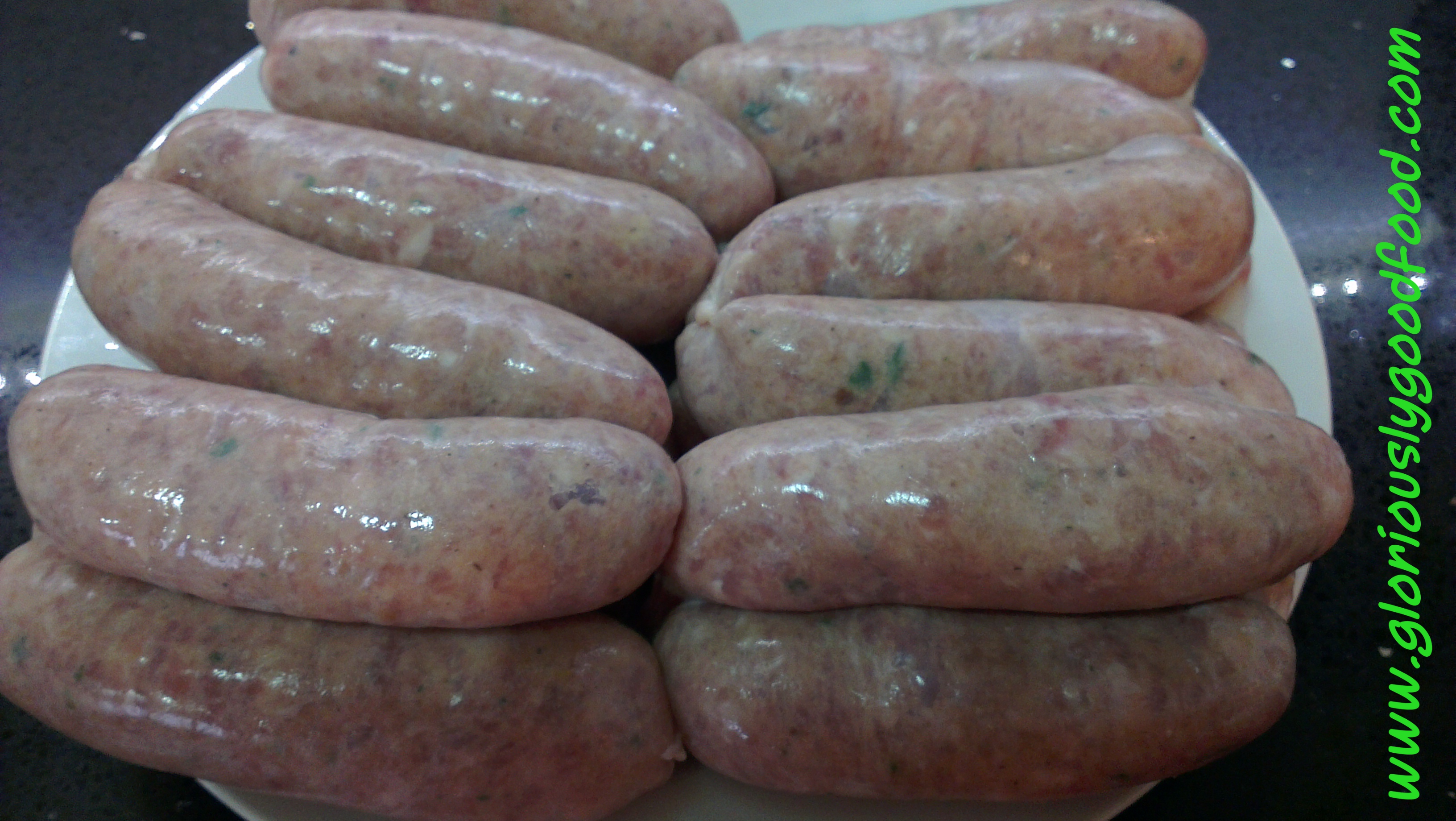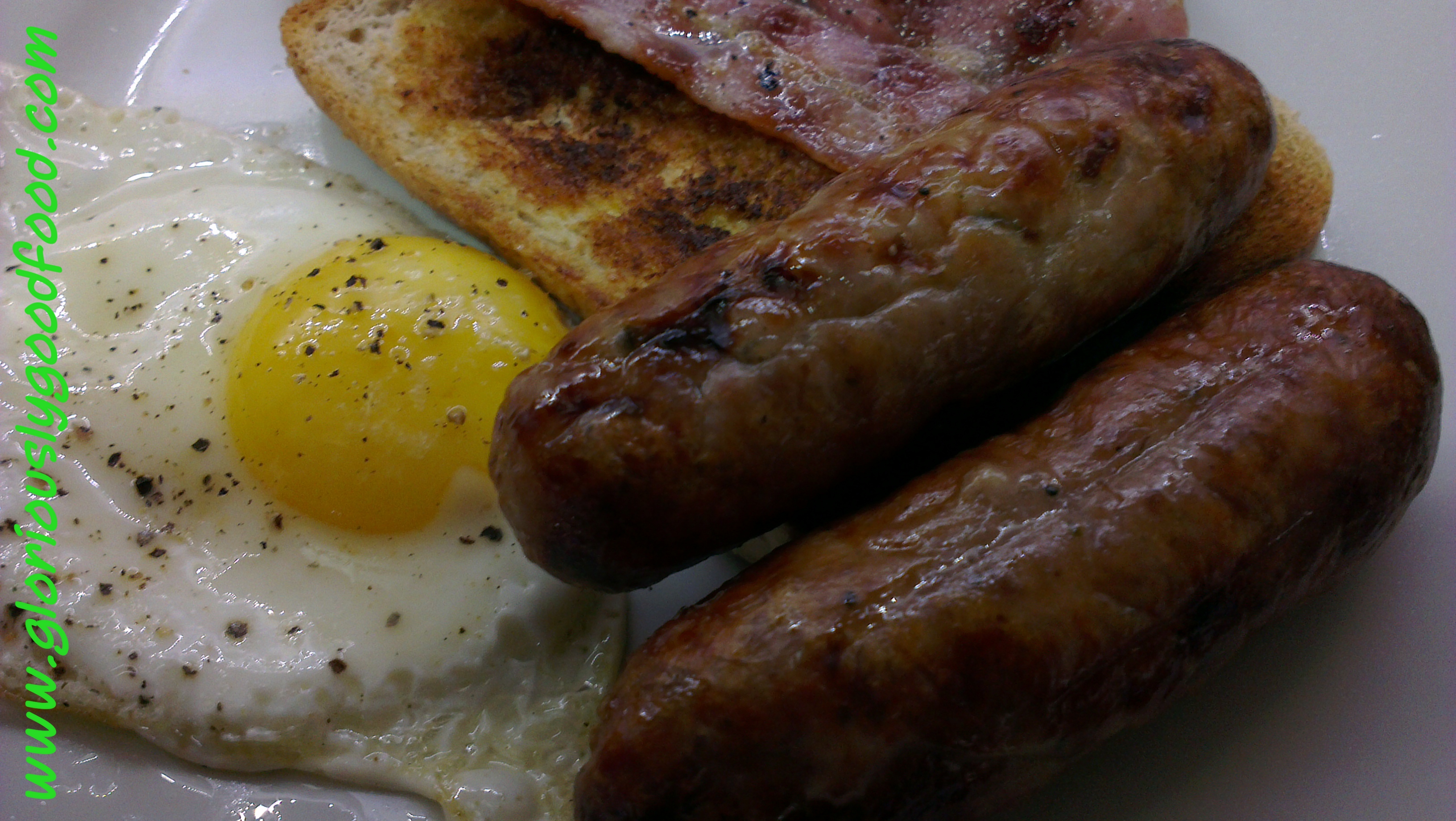Lincolnshire sausages are a firm Sunday breakfast favourite in our house!
Naturally, therefore, after the Sardinian Sausages, our next foray into sausage-making had to be Lincolnshire Sausages…
After a bit of playing around to get the quantities right on the herbs and seasoning, hubby and I are delighted that we’ve cracked it and made bangers to be proud of! 🙂
The quantities indicated here will make approximately 25-30 sausages, depending on how long & thick you make yours. Ours were very chunky indeed! You can use collagen casings but we’ve opted for natural ones. The large ones you use for making Lincolnshire Sausages are quite easy to use even if you buy them as hank, as we did on this occasion, but in future we will buy them spooled as they should be even easier to handle. I found a site that sells them HERE. A huge ‘thank you’, on this occasion though, to Ben Marshall Butchers at Doncaster Market, for supplying us with the casings and for the outstanding quality of the meat they sold us 🙂
Ingredients:
- 1.7kg pork (mixture of shoulder & belly) – ask your butcher to remove the rind, leaving as much fat as possible on and then cut into chunks you can put through your mincer/grinder
- 360g breadcrumbs (use fresh soft bread – not with hard crusts – and put through a food processor to make crumbs)
- 3tsp fine sea salt
- 1.5tsp freshly-ground black pepper
- 1tsp ground coriander
- 16 large fresh sage leaves (either finely-chop by hand or, ideally, put through the grinder/mincer with the meat)
- 2tsp freshly-grated nutmeg (use a very fine grater)
- 2tsp cornflour
- 400ml cold water
- Natural Hog Casings (casings for thick sausages)
Method:
Add the salt, pepper, coriander, sage leaves and nutmeg to the meat and mix together (you can leave to marinate/infuse for a couple of hours if you like).
Put through a meat grinder/mincer on a wide/chunky setting.
Make the breadcrumbs in a food processor, then add to the meat, herb & seasoning mixture and add the water and cornflour. Mix well by hand to ensure the flavours and all ingredients are evenly spread. The breadcrumbs and meat will absorb the water and you’ll end up with a pasty/sticky mixture.
Thread the natural casings over your sausage maker nozzle and feed the mixture through. Do this slowly and let the sausages get as thick as you’d like them to. Work on a long continuous length for each 10-12 sausages, twisting to separate each time you’ve reached the desired length for one sausage.
You can then either refrigerate/freeze them linked as they are, or separate by cutting through at the twisting points with scissors and freezing them individually.
These Lincolnshire sausages are very cost-effective (ours worked out at about £0.50 per sausage to make) and you know exactly what’s in them! Food doesn’t get much better 🙂
Update 9th November 2015
Emma Simkiss and her husband chose this recipe to use for Emma’s first video on her brand new YouTube channel…it’s a fab video! Take a look:



Thanks for sharing this recipe. We made these over the weekend and they tasted fantastic! I put rather more sage in and added some thyme as well.
That is wonderful to hear! Thank you so much for getting in touch to let me know 🙂
Its not a Lincolnshire sausage.
Your comment needs a bit more detail. Why not?
Its not a Lincolnshire sausage.
Your comment needs a bit more detail. Why not?
Soooo today my husband and I decided to make this recipe, our first time making sausages (and the first video for me new YouTube channel) so I thought I should share the video with you…..enjoy! https://www.youtube.com/watch?v=BL7e6GvVQUQ
LOVED the video, thank you so much for making it and sharing it…and for allowing me to embed it into the original recipe post 🙂
Soooo today my husband and I decided to make this recipe, our first time making sausages (and the first video for me new YouTube channel) so I thought I should share the video with you…..enjoy! https://www.youtube.com/watch?v=BL7e6GvVQUQ
LOVED the video, thank you so much for making it and sharing it…and for allowing me to embed it into the original recipe post 🙂
Thank you for posting this! I had bangers and mash with Lincolnshire sausage in Lincoln, and just fell in love with the dish. But, here in the States, I don’t really trust any of the commercially available sausages to come anywhere near that quality, and the sausage makes the dish! So, now, I guess all I need to do is get a hold of a meat grinder…oh, btw, the official Lincolnshire sausage site says that the pork should be “minimum 70%”, which I assume is the lean/fat ratio of 70/30. They also say they only add sage, salt, and pepper (aside from the bread crumbs), but I’m sure the coriander tastes wonderful!
A bit of ‘poetic license’ on my part, perhaps…though like with most traditional recipes, there are so many variations around 😉 My personal preference is to go for fattier meat in sausages, hence I use shoulder and belly, but that could be because I’m Italian and in Italy we tend to have fattier sausages. I would recommend experimenting with the recipe until it matches your tastebuds’ recollection of what you ate in Lincoln 🙂 Let me know how you get on – once you’ve sourced a meat grinder!
Thank you for posting this! I had bangers and mash with Lincolnshire sausage in Lincoln, and just fell in love with the dish. But, here in the States, I don’t really trust any of the commercially available sausages to come anywhere near that quality, and the sausage makes the dish! So, now, I guess all I need to do is get a hold of a meat grinder…oh, btw, the official Lincolnshire sausage site says that the pork should be “minimum 70%”, which I assume is the lean/fat ratio of 70/30. They also say they only add sage, salt, and pepper (aside from the bread crumbs), but I’m sure the coriander tastes wonderful!
A bit of ‘poetic license’ on my part, perhaps…though like with most traditional recipes, there are so many variations around 😉 My personal preference is to go for fattier meat in sausages, hence I use shoulder and belly, but that could be because I’m Italian and in Italy we tend to have fattier sausages. I would recommend experimenting with the recipe until it matches your tastebuds’ recollection of what you ate in Lincoln 🙂 Let me know how you get on – once you’ve sourced a meat grinder!
It does not say What TSP IS it Tea spoons or Table spoons ?????????
Hi there, generally in UK recipes, ‘tsp’ is teaspoon and ‘tbsp’ is tablespoon. Sorry for any confusion.
It does not say What TSP IS it Tea spoons or Table spoons ?????????
Hi there, generally in UK recipes, ‘tsp’ is teaspoon and ‘tbsp’ is tablespoon. Sorry for any confusion.
We are the proud owners of a new sausage machine and your recipe has been used twice over now, very successfully. Thank you. PS we are in France and we really missed a good English sausage. Not any more. Even the French like them.
Thank you Joy – that is wonderful to read! 🙂
We are the proud owners of a new sausage machine and your recipe has been used twice over now, very successfully. Thank you. PS we are in France and we really missed a good English sausage. Not any more. Even the French like them.
Thank you Joy – that is wonderful to read! 🙂
This recipe has a good flavir for is very tame compared toba proper lincolnshire sasusage
Just up the salt and pepper and you will have an even better sasusage .m
Thanks Michael – of course seasoning is very individual. Just add salt & pepper as appropriate 🙂
This recipe has a good flavir for is very tame compared toba proper lincolnshire sasusage
Just up the salt and pepper and you will have an even better sasusage .m
Thanks Michael – of course seasoning is very individual. Just add salt & pepper as appropriate 🙂
Tried your recipe for the first time, and my partner absolutely loved it.
Thank you so much for sharing this recipe.
Thank you very much for your feedback Mary Ann. I’m delighted you enjoyed the recipe 🙂
Tried your recipe for the first time, and my partner absolutely loved it.
Thank you so much for sharing this recipe.
Thank you very much for your feedback Mary Ann. I’m delighted you enjoyed the recipe 🙂
[…] http://blog.gloriouslygoodfood.com/2013/05/17/lincolnshire-sausages/ […]
[…] http://blog.gloriouslygoodfood.com/2013/05/17/lincolnshire-sausages/ […]
You should not use fresh breadcrumbs from mass produced bread because of the yeast content. If using mass produced bread, then you should bake-off the bread in the oven to make it completely dry before blitzing and adding to your meat qand seasoning mix.
Hi Tim
Thanks for your comments. It’s not something I’ve heard before and the sausages were delicious with the fresh bread (home-made bread would have quite a high yeast content, too?), but I may try as you suggested next time. Cheers 🙂
You should not use fresh breadcrumbs from mass produced bread because of the yeast content. If using mass produced bread, then you should bake-off the bread in the oven to make it completely dry before blitzing and adding to your meat qand seasoning mix.
Hi Tim
Thanks for your comments. It’s not something I’ve heard before and the sausages were delicious with the fresh bread (home-made bread would have quite a high yeast content, too?), but I may try as you suggested next time. Cheers 🙂